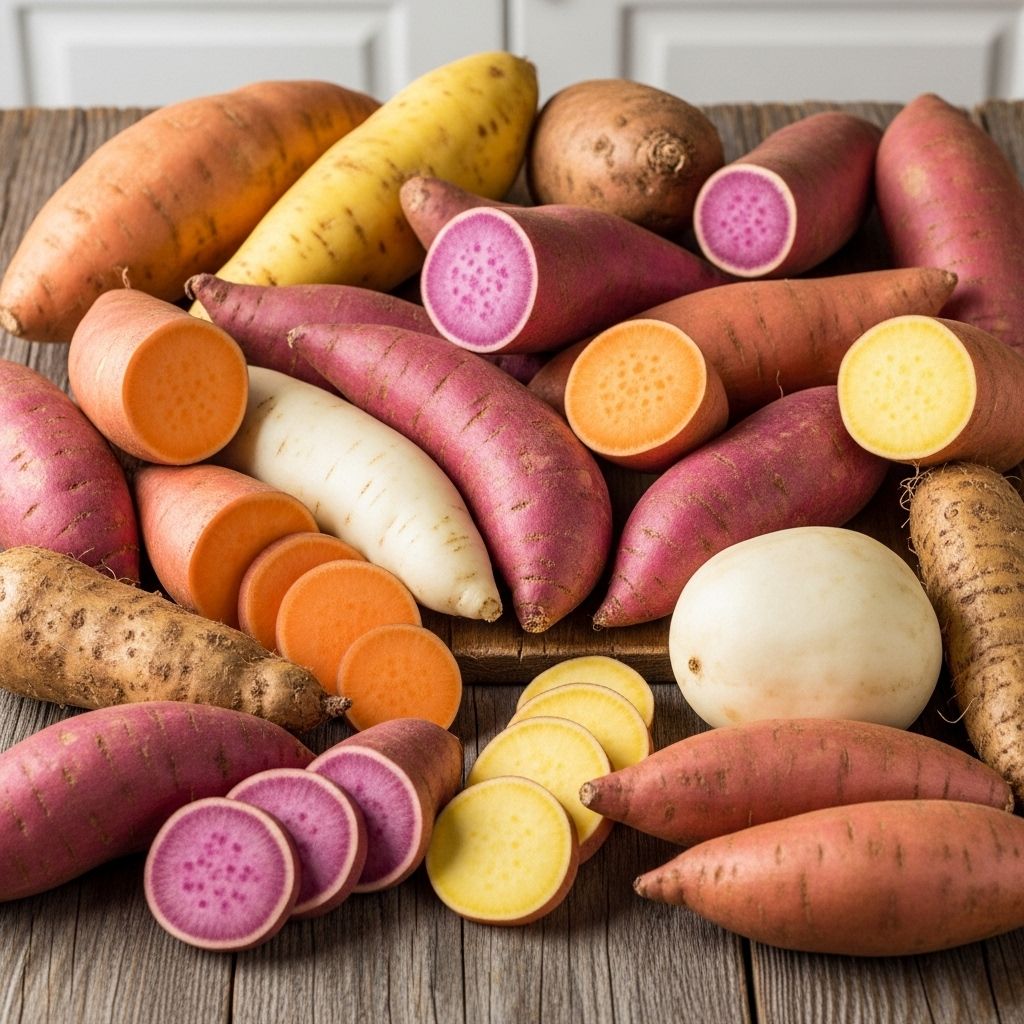Sweet Potato Varieties: Complete Guide To Types And Yam Myths
Explore a spectrum of colors and textures to perfect every hearty, flavorful side dish.

A Field Guide to Sweet Potato Varieties (and the Truth About Yams)
Few ingredients span continents, cuisines, and holidays like the sweet potato. It’s a vegetable of astonishing diversity—ranging in flesh and skin color, flavor notes, and ideal uses in the kitchen. Yet, confusion surrounds sweet potatoes and so-called “yams,” with many shoppers unaware of the differences or myths behind the names. This comprehensive guide explores the colorful world of sweet potatoes, dispels widespread yam misconceptions, and provides actionable guidance on how to select, use, and cook each variety for optimal flavor and texture.
What Are Sweet Potatoes?
Sweet potatoes (Ipomoea batatas) are starchy, sweet-tasting root vegetables native to Central or South America. Unlike regular white potatoes, they’re not from the nightshade family, but rather morning glory relatives. Their orange, yellow, white, or purple flesh can be moist or dry, dense or fluffy, depending on variety. Sweet potatoes are nutritionally rich, packed with fiber, vitamins (notably vitamin A), and antioxidants.
Yams vs. Sweet Potatoes: Clearing Up the Confusion
In American supermarkets, the words ‘yam’ and ‘sweet potato’ are often used interchangeably, but these are not the same vegetable:
- Sweet potatoes: Part of the morning glory family, sweet-tasting, with thin skin and a range of flesh colors from orange to white to purple.
- True yams (Dioscorea species): Native to Africa and Asia, true yams are rough, bark-like tubers with starchy, dry flesh that can be white, yellow, or purple, and are much larger than sweet potatoes. They are uncommon in U.S. supermarkets, except in specialty stores catering to West African, Caribbean, or Asian communities.
The root of the confusion lies in Southern U.S. history: to distinguish the soft, orange-fleshed sweet potato from firmer, pale types, growers began calling the former “yams”—adapted from the West African word nyami. Government regulations now require that anything labeled ‘yam’ in the U.S. must also carry the term ‘sweet potato,’ underscoring that the two are botanically distinct.
Types of Sweet Potato Varieties
Sweet potatoes can be classified by their skin and flesh color, as well as by flavor and texture. Many varieties are available, but the following are among the most prominent in North America and internationally.
Orange-Fleshed Varieties
- Beauregard
The quintessential supermarket sweet potato. Developed in Louisiana, Beauregard has reddish skin, vibrant orange flesh, and a moist, very sweet flavor. These cook up with a smooth, fluffy texture and are ideal for baking, casseroles, mashing, and pies. - Jewel
Copper skin and deep orange flesh, very sweet and moist. Another go-to for holiday dishes—similar to Beauregard but sometimes with more pronounced earthy notes. - Garnet
Also called ‘red yam’ in stores (though not botanically a yam). Garnet has reddish-brown skin and moist, orange flesh, with a pronounced, sweet taste. It holds its shape beautifully when roasted or sliced for fries. - Covington
Smooth, rose-colored skin and orange flesh, widely grown in North Carolina. Less moist than Beauregard, but with robust sweetness, making it versatile for baking, roasting, or mash. - Carolina Ruby
Notable for its rich red skin and deep orange interior. Roasts well and has a sweet, moist texture when baked, often used in specialty or heirloom markets.
White- and Yellow-Fleshed Varieties
- Hannah
Tan skin with ivory flesh that turns golden when cooked. The texture is dense, dry, and mildly sweet—think of a crossover between a regular potato and a sweet potato. Great for fries, cubes, and roasting. - O’Henry
A mutation of Beauregard, sporting pale skin and creamy, off-white flesh. Less sweet than orange types but still moist. - Japanese (Murasaki)
Reddish-purple skin with white flesh. Developed in Louisiana, now widely grown in California. Mildly sweet with nutty, chestnut-like notes. The flesh is starchy and moist rather than dry, making it perfect for roasting, mashing, or desserts. - Batata
Pale yellow skin and white flesh, grown mainly in the Caribbean. Mild sweetness and pronounced starchy texture, making them excellent for boiling, mashing, or adding to stews.
Purple-Fleshed Varieties
- Stokes Purple
Discovered in North Carolina. Lavender skin with vibrant purple flesh, dense and dry, with a moderately sweet, wine-like flavor. High in antioxidants, ideal for roasting, baking, or unique-hued mashed potatoes. - Okinawa (Hawaiian)
Tan skin and intense purple flesh. Drier and firmer than standard sweet potatoes, with a distinctively sweet, nutty flavor. Popular in Pacific Rim cuisines and prized for both color and taste. - Korean Purple
Purple skin with pale, creamy flesh, firm and sweet. Widely grown in East Asia for both savory and dessert dishes. - Speckled Purple
An unusual variety with purple skin and mottled flesh that’s sweet and mild when baked or roasted.
Other Notable Varieties
- Vardaman
Known for compact or ‘bush’-type vines (ideal for small gardens), with golden skin and deep orange flesh. Both ornamental and delicious, especially roasted. - Sumor
Light tan skin and yellow flesh, less sweet than orange types, very high in vitamin C. - Willowleaf
An heirloom with fine, slender leaves and roots; mild and sweet, often grown for novelty and historical interest. - West African Sweet Potatoes
Creamy exterior and fluffy, nutty inside—pillars of local cuisines in Africa, especially in stews and mashes.
Main Differences: Sweet Potatoes at a Glance
| Variety | Skin Color | Flesh Color | Texture | Best Uses |
|---|---|---|---|---|
| Beauregard | Reddish | Orange | Moist, fluffy | Baking, mashing, casseroles |
| Jewel | Copper | Deep orange | Moist, sweet | Baking, pies |
| Garnet | Dark red | Orange | Moist | Roasting, fries |
| Hannah | Tan | Ivory/gold | Dry, dense | Fries, cubes, mashing |
| Japanese (Murasaki) | Reddish-purple | White | Starchy, moist | Roasting, desserts |
| Stokes Purple | Lavender | Purple | Dense, dry | Roasting, baking |
| Okinawa | Tan | Purple | Dry, firm | Baking, mashing, desserts |
| Vardaman | Golden | Orange | Moist | Roasting, mashing |
| Sumor | Light tan | Yellow | Dry, less sweet | Boiling, salads |
| Batata | Pale yellow | White | Starchy | Boiling, soups, stews |
How to Select and Store Sweet Potatoes
- Look for: Firm, smooth skin with no soft spots or bruising. Small to medium roots are generally more tender.
- Avoid: Signs of wrinkling, sprouting, or mold, which indicate age or spoilage.
- Storage: Keep sweet potatoes in a cool (but not cold), dark, and well-ventilated place for up to three weeks. Do not refrigerate, as cold temperatures can harden their core and affect flavor and texture.
Cooking Techniques and Flavor Profiles
The spectrum of sweet potato flavors runs from earthy and mildly sweet to honeyed and rich. Texture divides into two main categories:
- Moist, sweet varieties (like Beauregard, Garnet, Jewel): Best for baking, mashing, casseroles, and desserts. Their higher sugar content caramelizes and offers a creamy finish.
- Dry, starchy varieties (like Japanese, Hannah, Stokes Purple): These hold their shape; excellent for roasting, fries, salads, and gratins. Their subtly sweet, sometimes nutty flavors suit savory pairings.
Try mixing varieties for layered flavor and texture in soups, medleys, or gratins.
Global Uses and Cultural Importance
Sweet potatoes are culinary chameleons:
- In the American South: Featured in pies, soufflés, candied or marshmallow-topped holiday bakes.
- In Japan and Korea: Roasted whole as street food, or transformed into glutinous cakes and tempura fillings.
- In the Pacific: The purple Okinawa variety stars in Hawaiian desserts.
- In Africa: Cream-fleshed varieties are key to stews, porridges, and everyday sustenance.
Common Myths About Yams and Sweet Potatoes
- Myth: Orange sweet potatoes are yams.
Truth: Almost all orange- and red-fleshed roots in U.S. stores labeled ‘yam’ are actually sweet potatoes. - Myth: Yams and sweet potatoes taste the same.
Truth: True yams are starchier, less sweet, often with a fibrous texture and are rare outside specialty shops. - Myth: All sweet potatoes are orange inside.
Truth: Sweet potato flesh can be orange, white, yellow, or purple.
Frequently Asked Questions (FAQ)
Are sweet potatoes and yams the same?
No. Sweet potatoes and yams are unrelated botanically, with distinct textures, flavors, and native regions. Nearly all ‘yams’ in American grocery stores are actually a type of sweet potato.
Why are sweet potatoes sometimes labeled ‘yams’?
The term ‘yam’ was a marketing distinction popularized in the U.S. South to differentiate soft, orange-fleshed sweet potatoes from firmer, pale-fleshed types. True yams are almost never found in mainstream U.S. supermarkets.
How do I know which variety to buy?
For traditional sweet, moist results in pies or casseroles, choose Beauregard, Jewel, Covington, or Garnet. For a drier, more starchy effect (such as for fries or roasting), seek out Hannah, Japanese (Murasaki), or Stokes Purple.
Can I eat sweet potato skin?
Yes, as long as it’s thoroughly scrubbed. The skin provides fiber and nutrients, though texture varies between varieties.
Are purple sweet potatoes healthier?
Purple-fleshed sweet potatoes are especially high in anthocyanins, potent antioxidants also found in berries. All sweet potatoes are rich in vitamin A, fiber, and micronutrients.
Tips for Cooking and Pairing Sweet Potatoes
- Pair sweet potatoes with contrasting flavors: Fresh herbs, sharp cheeses, crisp apples, or tangy citrus all complement sweet potato’s earthy sweetness.
- Roast with spices like cumin, paprika, or cinnamon to highlight natural sugars.
- Boiled or steamed sweet potatoes are perfect for mash, but roasting or baking concentrates flavor and sweetness.
- Use a mix of colorful varieties for visual appeal in salads, grain bowls, and trays.
Conclusion
From the creamy flesh of Beauregard to the intense purple of Okinawa, sweet potatoes offer a world of flavors, textures, and colors to explore. While yams and sweet potatoes are often conflated in the U.S., true yams are a different vegetable altogether. Understanding this distinction, and the unique qualities of each sweet potato variety, will help you select the perfect spud for every dish—whether roasting, baking, frying, or mashing. Embrace the diversity on your next market visit, and taste your way through the sweet potato spectrum!
References
- https://snackjacksons.com/blogs/blog/guide-to-the-types-of-sweet-potatoes
- https://www.jessicagavin.com/types-of-sweet-potatoes/
- https://www.saveur.com/gallery/16-Shades-of-Sweet/
- https://en.wikipedia.org/wiki/List_of_sweet_potato_cultivars
- https://potatoes.cals.ncsu.edu/sweetpotato/sweetpotato-varieties/
Read full bio of Shinta












